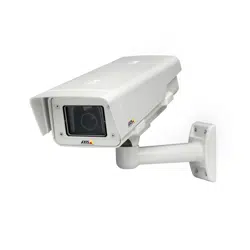Loading ...
Loading ...
Loading ...

AXIS Q1604–E Network Camera
System Options
The following traps are available:
•Coldstart
•Warmstart
•Linkup
• Authentication failed
SNMP v3 provides encryption and s ecure passwords. To use traps with SNMP v3, an SNMP v3 management application is required.
To use SNMP v3, HTTPS must be enabled, see
HTTPS, on page 36
. To enable SNMP v3, check the box and provide the initial user
password.
Note
The initial passwo rd can o nly be set once. If the password is lost, the Axis product must be reset to factory default, see
Reset to factory default settings, on page 45
.
UPnP
TM
The Axis product includes support for UPnP
TM
.UPnP
TM
is enabled by default and the product is automatically detected by operating
systems and clients that support this protocol.
UPnP
TM
can b e disab le d under System Options > Network > UPnP
TM
.
RTP/H.264
The RTP port range and multicast settings a re configured under System Options > Network > RTP.
The RTP port range defi nes the range of ports from which the video/audio ports are auto
matically selected. For multicast streams,
only certain IP addresses and port numbers should be used.
Select Always Multicast Video and/or Always Multicast Audio to start multicast streamin g without opening an RTSP session.
Bonjour
The Axis product includes support for Bonjour. Bonjour is enabled by default and the product is automatically detected by operating
systems and clients that support this protoc
ol.
Bonjour can be disabled under System Op
tions > Network > Bonjour.
Storage
SD card
The SD/SDHC memory card (not included) is managed on the System Options > Storage page. Click SD card to open Storage
Management.
Mounting is done automatically when the card is inserted or when the product boots. SD cards are normally preformatted w hen
purchased, but if needed, click Format to format the card.
Format an SD card so that it can be written to one of two available options — VFAT and ext4. During the formatting any previous
data stored on the disk will be lost. The recommended format is ext4, due to its resilience against data loss if the card is ejected
or if there is a brupt power loss. A third-party ext4 dr iver or application is also needed to access the fi le system from Windows.
Note that most SD cards are pre-formatted with vFAT when purchased. The Check Disk option is used to check for errors on the SD
card and only works for the file system ext4. The Repair option repairs the SD card of errors in the file system ext4. For vFAT file
system use a card reader or PC to perform card maintenance.
Note
To prevent corruption of recordings, the SD card should always be unmounted before remo val.
42
Loading ...
Loading ...
Loading ...
